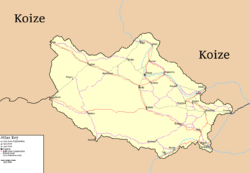Archive:Hodek
| Republic of Hodek Fegedneny Hodekluya Fegedneny Hodekluya Fegedneny Hodekluya |
||||
|---|---|---|---|---|
|
||||
| Anthem: Salsne Nankiye The Mountain of the United |
||||
| Location |  Map of Hodek including local major infrastructures |
|||
| Capital and largest city | Tékely | |||
| Official languages | Hodeki Koizan |
|||
| Recognised national languages | Terminian Balak |
|||
| Recognised regional languages | TBD | |||
| Ethnic groups | ||||
| Demonym | Hodeki | |||
| Government | Unitary dominant-party presidential constitutional republic | |||
| - | Chairman of the Independence Party | Babfyed Sóvtamuk | ||
| - | President | Kyígfyed Balnekk | ||
| - | Prime Minster | Kúkliffyed Tórme | ||
| - | Prime Minster | Terdegcag Ólai | ||
| - | Chairman of the Hodeki Armed Forces | Mafsfyed Fíkyhand | ||
| Legislature | Parliament | |||
| - | Upper house | Fegedneny | ||
| - | Lower house | Ílgelneny | ||
| Area | ||||
| - | Total | 775,111 km2 481,631 sq mi |
||
| Population | ||||
| - | 2018 census | 1317688 | ||
| - | Density | 1.7/km2 2.735/sq mi |
||
| GDP (nominal) | estimate | |||
| - | Total | $7.1 Billion USD | ||
| - | Per capita | $5,430 USD | ||
| Gini | 36.9 medium |
|||
| HDI | 0.792 high |
|||
| Date format | dd/mm/yyyy | |||
| Drives on the | right | |||
| ISO 3166 code | HDK | |||
| Internet TLD | .hk | |||
Hodek, known officially as the Republic of Hodek (Hodeki: Fegedneny Hodekluya, Fegedneny Hodekluya, tr. Fegedneny Hodekluya, [feɢedneɲ‿ɦodeqɬujɒ]), is a landlocked country located within Central Miraria and north of the Miralayas. It is partially bordered to the East along the TBD and Cakar rivers. It is bordered with the nations of Koize and TBD(s?). It is 4th least densely populated nation upon Sahar, with the lesser densely populated nations as Achiyitqana, Translira, and Nolcik being less densely populated. Its official languages of Hodeki and Koizan are of Ryamaian and Mahavi descent respectively, as Hodeki is itself a language isolate belonging to the greater Ryamaian language family making it related to the Vaniuan languages, though it is closely related to the Sirchak languages within Ensia and Suenia. For centuries prior to its independence in 1828, Hodek saw no true national identity and was a series of various tribal entities belonging as tributaries or vassal clans to the Mahavi Khanates following the expansion of the Sunrise Horde.
During the 1800s, Hodek's population saw an upswing as a result of migration following the discovery of gold along the upper Cakar river tributaries. This spur in migration during a period of instability between various regions along the Parshita brought many peoples to Hodek, further improving its technological and economic base. Within 20 to 30 years, Hodek's economy had improved, but civil war led to Kuulist collectivization efforts resulting in stagnation of the economy, as well as an exodus of many educated individuals as a result of purges within the government and military. Despite surviving several Koizan military incursions, eventually Hodek's Kuulist government collapsed in 1954 after two years of protests and insurrection. For most of the following period, Hodek has yet to recover from the Kuulist collectivization efforts, and has only slowly returned to being a recognizable 2nd World nation as a result of foreign assistance and efforts to bring in educated individuals to reverse the brain drain from 70 years earlier. Hodek today performs favorably in regards to civil liberties, press freedom, democratic governance, and its respect of equal rights for the Vodholk minority groups within the country.
Etymology
The source of the name Hodek is of unknown origin with several suggestions put forth to explain the source of the name. The most popular belief amongst linguists is the compound of the words from Proto-Degic *kod "fine/quality" and *eki meaning "to wash/that which is washed". Other theories is from the formations of *hu- "By/Near" and *dek meaning "together, connected" referring to the congregation of the Cakar and TBD rivers.
